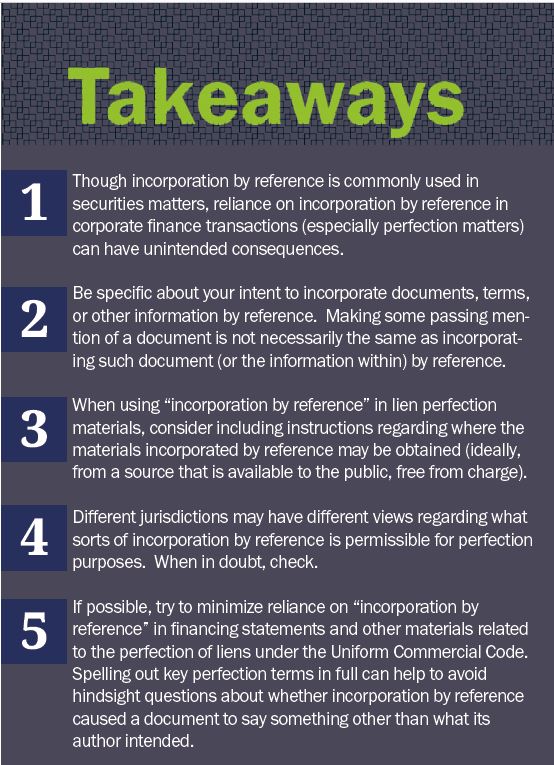- The “New Normal” Roundtable
- The Digital Transformation is Severely Disrupting Retail: The Time for Action is Now
- Members of SFNet’s Factoring Committee Discuss Sources of Business, Supply Chain Issues and More
- What a Lender Needs to Know: Key Loan Document Terms in a Time of Crisis
- Factoring Industry Remains Resilient Amid Economic Shifts
Isn’t That What it Says? --Potential Perils of Incorporation by Reference in Finance Transactions
By Brian Smith
Commercial lending transactions are memorialized with a comprehensive, and often voluminous, set of loan documentation. In an attempt to expedite closing, and reduce closing binder sizes, lenders (and their counsel) are always seeking ways to streamline the loan documentation process. On occasion, lenders may be tempted to simplify documentation by relying on “incorporation by reference” - i.e., within document A, merely referring to certain terms in document B (and incorporating them within document A), instead of spelling out the same terms and provisions in both document A and document B. Such use of “incorporation by reference” sounds appealing (why say the same thing in two different documents?) and, in some instances, “incorporation by reference” can be an appropriate strategy for producing more concise loan documentation.
However, a few recent cases show that blind reliance on “incorporation by reference” can occasionally have disastrous (and unintended) consequences for secured lenders. These cases do not state that “incorporation by reference” can never be done. Still, the scrutiny that the courts in these cases applied before narrowly approving, or denying, attempts to validate key deal terms that were allegedly “incorporated by reference” may lead many lenders to question whether the space saving from incorporation by reference is worth the potential risk of having the propriety of “incorporation by reference” challenged at some point in the future in a “hindsight” review.
In re Financial Oversight and Management Board for Puerto Rico – The Perils of Incorporation by Reference Within UCC Financing Statements
The first, and perhaps most troubling, example of unexpected “incorporation by reference” consequences entails the use of “incorporation by reference” to describe collateral in a Uniform Commercial Code financing statement. Such unintended consequences of incorporation by reference for perfection purposes placed the secured lenders from In re Financial Oversight and Management Board for Puerto Rico1 on the precipice of a $2.9 billion perfection failure.
In the Financial Oversight and Management Board case, the lenders extended almost $2.9 billion of credit to a Puerto Rico government agency that had recently been authorized to borrow to address underfunded pension liabilities. Such secured credit extension was authorized by a pension funding resolution referred as the “Resolution”. Among other things, the “Resolution” authorized the government agency to grant a security interest in certain “Pledged Property” to secure its borrowings and provided a definition for what constituted “Pledged Property.”
As every lender knows, maintaining a validly perfected security interest is crucial to preserving the priority and validity of a lien during an insolvency proceeding. Furthermore, as lenders are aware, perfection requires both (a) attachment of a security interest in certain property(generally accomplished via a security grant set forth in a written security agreement) and (b) some further act to perfect the attached security interest (most commonly, filing a UCC financing statement describing the collateral subject to the security agreement). Consistent with such perfection requirements, the Financial Oversight and Management Board lenders both (a) entered into a written security agreement granting the lenders a security interest in the “pledged property” and (b) filed a UCC financing statement that indicated a security interest in certain “pledged property.”
Though this may sound like a standard (and otherwise appropriate) way to ensure a validly perfected lien against the “pledged property,” these efforts did not spare the lenders an almost catastrophic perfection challenge because both the security agreement, and the lenders’ initial financing statement, relied upon “incorporation by reference” to describe the “pledged property” collateral. Specifically, the lenders’ security agreement did not define the term “pledged property” within the four corners of the security agreement. Instead, it incorporated by reference the term “pledged property” set forth in the Resolution. Similarly, the lenders’ initial UCC financing statement did not contain a description of “pledged property” within the four corners of the financing statement. Instead, it attached (and incorporated) the security agreement, which, in turn, incorporated by reference the “pledged property” definition in the Resolution.
When Puerto Rico instituted a court-supervised restructuring, the lenders’ perfection efforts were challenged due to reliance on terms outside of the financing statement to describe the lenders’ collateral. According to the challenging parties, because a financing statement reader would need to go outside the four corners of the financing statement to determine what constituted the “pledged property” collateral, the financing statement did not sufficiently describe the collateral as required under UCC 9-504, and was thus defective and ineffective for perfection purposes.
In response, the lenders claimed that the financing statements were sufficient for perfection purposes because the financing statement is merely a notice filing, intended to appraise other parties of the existence of some potential security interest against “pledged property” (even if more investigation would be required to discern the parameters of that security interest). Furthermore, the Resolution was a publicly available document (though the lenders’ UCC financing statement did not contain any directions for how to obtain copies of the Resolution).
Troublingly for the lenders, both the trial court, and the First Circuit Court of Appeals, concluded that the lenders’ reliance on incorporation by reference rendered their initial financing statements defective and unable to perfect their $2.9 billion of secured indebtedness. Though the First Circuit did not hold that incorporation by reference in a financing statement was per se improper, it did hold that on the facts presented, the lenders’ financing statement was defective because, among other things: (i) the term “pledged property” was not defined within the four corners of the financing statement, (ii) the financing statement did not tell readers where they could locate the Resolution, and (iii) the Resolution itself was not contained within the UCC filing office. Furthermore, though the First Circuit noted that although interested parties could have contacted the debtor (or some other party) to obtain more information about the “Pledged Property,” that should not change the result, as requiring other persons to engage in further inquiry to determine the scope of the collateral would conflict with UCC notice policy.
Ultimately, the Financial Oversight and Management Board lenders were spared a disastrous perfection failure because a subsequent amendment to their initial, defective UCC financing statement did include a definition of the “pledged property” in the financing statement itself and thus perfected the lenders’ security interest as of the date of the amendment. Such subsequent perfection may not have insulated the lenders against intervening liens that were filed between the date of the initial (defective) financing statements and the later (effective) amendments, but intervening filings were not an issue in this case.
Again, the Financial Oversight and Management court did not hold that incorporation by reference could never be used for perfection purposes, and other courts, under similar facts, have held that incorporation by reference that was substantially identical to the incorporation by reference used by the Financial Oversight and Management lenders was indeed sufficient for perfection purposes.2 However, the mere fact that more almost $2.9 billion of security interests was placed in jeopardy because of shortcut taken when preparing the financing statement will likely give other lenders pause before relying solely on incorporation by reference for future UCC filings.
The Financial Oversight and Management Board case also strongly suggests that if any materials are incorporated by reference into a financing statement, the financing statement should have a description of where to obtain copies of the materials incorporated by reference. Thus, for any UCC filings that use incorporation by reference, lenders would be wise to consider including instructions for where the incorporated materials can be located (even better if they can be obtained free of charge).

In re Linn Energy – Intent to Incorporate Materials by Reference Must Be Explicit
Another potential pitfall of incorporation by reference is that the intent to incorporate must be explicit. Failure to sufficiently indicate an intent to incorporate a document by reference can prevent the effectiveness of the attempted incorporation and inject unwanted uncertainty into a transaction. Such reliance on insufficiently explicit incorporation by reference language recently cost a group of lenders millions of dollars of default interest in connection with the Linn Energy plan.3
In Linn Energy, the parties disputed the impact of two potentially competing terms within the confirmed chapter 11 plan for the Linn Energy debtors. One provision of that plan specifically allowed the Linn lenders’ claims in a specific principal amount, together with “other obligations arising under or in connection with the [proofs of claim filed by the Linn Lenders].” The other provision of the Linn Energy plan provided that “unless specifically provided for in the Plan or Confirmation Order”, default interest would not accrue in respect of allowed claims.
The Linn lenders claimed that the plan had otherwise specifically provided for an award of default interest because their proofs of claim specifically included default interest, and the plan specifically allowed “other obligations arising under or in connection with the [proofs of claim].” In essence, this was an argument that the default interest terms set forth in the Linn lender proofs of claim was incorporated by reference into the plan’s treatment of the Linn lenders.
In contrast, the Linn debtors claimed that the language prohibiting default interest was controlling. They claimed that such language must control because nowhere in the plan itself was there any mention of paying default interest to the Linn lenders – a reader would have to go outside the plan (to the lender proofs of claim) to find any mention of default interest.
Though the Court noted that both interpretations were potentially colorable, it held the debtor’s interpretation was clearly the better one because there was nothing within the plan itself specifically allowing default interest in a manner to override the plan’s general prohibition against default interest. Acknowledging that the plan did make some mention to the lenders’ proof of claim forms, the Court held that the plan would have led a reader to understand that there was an intent to incorporate the proof of claim’s default interest provisions into the plan. In other words, there was not requisite specificity for any purported incorporation by reference of the proof of claim’s default interest language (and thus, nothing the plan specifically overriding the plan prohibition against paying default interest).
The Financial Oversight and Management Board and Linn Energy cases highlight the sorts of unintended consequences that excessive reliance on incorporation by reference can have for perfection and claim allowance purposes. Though both cases confirm that incorporation by reference remains a viable tool for documenting loan transactions, the “hindsight” questioning in both cases regarding what was incorporated (or whether anything was incorporated) should serve as a reminder that lenders should be deliberate, thoughtful, and transparent about their use of incorporation by reference. Such deliberate, thoughtful use of incorporation by reference will help to avoid injecting unwanted future uncertainty regarding whether a document says what it was expected to say.
1 In re Financial Oversight and Management Board for Puerto Rico, 914 F.3d 694 (1st Cir. 2019).
2 See In re I80 Equipment, LLC, 938 F.3d 866 (7th Cir. 2019)
3 In re Linn Energy, LLC, 927 F.3d 350 (5th Cir. 2019).

